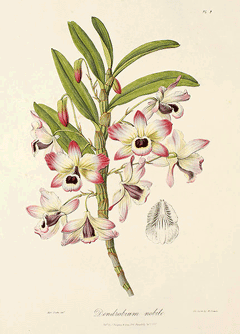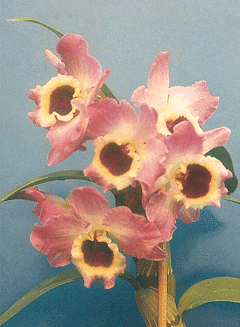 |
|
http://commons.wikimedia.org/wiki/File:Dendrobium_nobile111.jpg |
 |
| http://www.larsen-twins.dk/ |
Translate this page:
Summary
Physical Characteristics

 Dendrobium nobile is an evergreen Perennial growing to 0.6 m (2ft). It is in leaf all year, in flower from March to May. The species is hermaphrodite (has both male and female organs).
Dendrobium nobile is an evergreen Perennial growing to 0.6 m (2ft). It is in leaf all year, in flower from March to May. The species is hermaphrodite (has both male and female organs).
Suitable for: light (sandy), medium (loamy) and heavy (clay) soils. Suitable pH: mildly acid, neutral and basic (mildly alkaline) soils. It can grow in semi-shade (light woodland) or no shade. It prefers moist soil.
UK Hardiness Map
US Hardiness Map
Synonyms
D. lindleyanum. D. coerulescens.
Plant Habitats
Woodland Garden Sunny Edge; Dappled Shade; Shady Edge;
Edible Uses
References More on Edible Uses
Medicinal Uses
Plants For A Future can not take any responsibility for any adverse effects from the use of plants. Always seek advice from a professional before using a plant medicinally.
The whole plant contains mucilage and the alkaloid dendrobine[283]. It is antiphlogistic, pectoral, sialogogue, stomachic and tonic[147, 178]. It is used in Vietnam as a tonic in the treatment of pulmonary tuberculosis, general debility, flatulence, dyspepsia, reduced salivation, parched and thirsty mouth, night sweats, fever and anorexia[283]. It is also said to be effective in the treatment of sexual impotence, arthralgia, lumbago, pain in the extremities etc[283]. The plant is harvested at the end of the growing season and dried for later use[283]. The dried plants are imbued with alcohol and steam cooked before use[283].
References More on Medicinal Uses
The Bookshop: Edible Plant Books
Our Latest books on Perennial Plants For Food Forests and Permaculture Gardens in paperback or digital formats.

Edible Tropical Plants
Food Forest Plants for Hotter Conditions: 250+ Plants For Tropical Food Forests & Permaculture Gardens.
More

Edible Temperate Plants
Plants for Your Food Forest: 500 Plants for Temperate Food Forests & Permaculture Gardens.
More

More Books
PFAF have eight books available in paperback and digital formats. Browse the shop for more information.
Shop Now
Other Uses
References More on Other Uses
Cultivation details
This species is cultivated as a medicinal plant in China[178]. A very ornamental plant[1]. The dried plant can come back into growth[178].
References Carbon Farming Information and Carbon Sequestration Information
Temperature Converter
Type a value in the Celsius field to convert the value to Fahrenheit:
Fahrenheit:
The PFAF Bookshop
Plants For A Future have a number of books available in paperback and digital form. Book titles include Edible Plants, Edible Perennials, Edible Trees,Edible Shrubs, Woodland Gardening, and Temperate Food Forest Plants. Our new book is Food Forest Plants For Hotter Conditions (Tropical and Sub-Tropical).
Shop Now
Plant Propagation
Seed - surface sow, preferably as soon as it is ripe, in the greenhouse and do not allow the compost to dry out. The seed of this species is extremely simple, it has a minute embryo surrounded by a single layer of protective cells. It contains very little food reserves and depends upon a symbiotic relationship with a species of soil-dwelling fungus. The fungal hyphae invade the seed and enter the cells of the embryo. The orchid soon begins to digest the fungal tissue and this acts as a food supply for the plant until it is able to obtain nutrients from decaying material in the soil[200]. It is best to use some of the soil that is growing around established plants in order to introduce the fungus, or to sow the seed around a plant of the same species and allow the seedlings to grow on until they are large enough to move.
Other Names
If available other names are mentioned here
Native Range
TEMPERATE ASIA: China (Guangxi Zhuangzu Zizhiqu, Guizhou Sheng, Hainan Sheng, Hubei Sheng (west), Sichuan Sheng (south), Xizang Zizhiqu (southeast), Yunnan Sheng), Hong Kong, Taiwan TROPICAL ASIA: Bhutan, India (northeast), Nepal, Laos, Myanmar, Thailand (north), Vietnam
Weed Potential
Right plant wrong place. We are currently updating this section.
Please note that a plant may be invasive in one area but may not in your area so it's worth checking.
Conservation Status
IUCN Red List of Threatened Plants Status :

Growth: S = slow M = medium F = fast. Soil: L = light (sandy) M = medium H = heavy (clay). pH: A = acid N = neutral B = basic (alkaline). Shade: F = full shade S = semi-shade N = no shade. Moisture: D = dry M = Moist We = wet Wa = water.
Now available:
Food Forest Plants for Mediterranean Conditions
350+ Perennial Plants For Mediterranean and Drier Food Forests and Permaculture Gardens.
[Paperback and eBook]
This is the third in Plants For A Future's series of plant guides for food forests tailored to
specific climate zones. Following volumes on temperate and tropical ecosystems, this book focuses
on species suited to Mediterranean conditions—regions with hot, dry summers and cool, wet winters,
often facing the added challenge of climate change.
Read More
Expert comment
Author
Lindl.
Botanical References
200266
Links / References
For a list of references used on this page please go here
Readers comment
© 2010, Plants For A Future. Plants For A Future is a charitable company limited by guarantee, registered in England and Wales. Charity No. 1057719, Company No. 3204567.